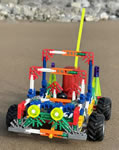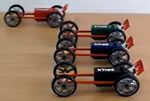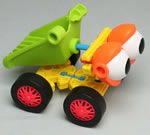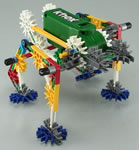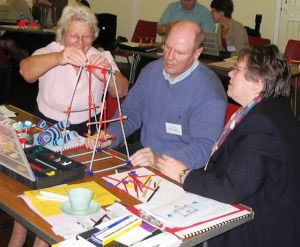
Post-16 education and training
K'NEX is increasingly being used in colleges and universities, by private companies, and in other forms of post-16 education and learning. This section of the website includes:
♦ Using K'NEX with students aged 16+
♦ Team-building with K'NEX
♦ K'NEX Aptitude tests
♦ Some issues to consider
♦ Case Study
Educators who are working with the 16-21 age group are helped by the fact that often a proportion of students will already have used K'NEX as a child at school or at home, and will be able to help other pupils who are new to K'NEX to get started.
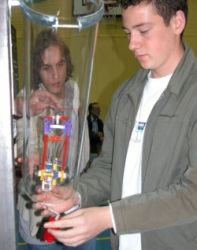
Using K'NEX with students aged 16+
K'NEX is used in many different post-16 educational settings, as:
♦ a versatile engineering system, which helps students to learn about subjects such as structural engineering in a hands-on way
♦ a vehicle for K'NEX Challenges that help to develop innovation skills, problem-solving skills and team-working skills
♦ a system for hands-on aptitude tests, that can help assess the skills of applicants in areas such as problem-solving, team-working and leadership.
The main curriculum areas for K'NEX are shown in the Curriculum pages. The versatility of K'NEX means that the same equipment can be used successfully with all ages post-16.
K'NEX sessions can also be delivered as accredited learning units.
Our K'NEX shop provides details of the many K'NEX education sets that are ideal for post-16 education and training. These sets are much larger and better value than the K'NEX sets you can buy in the shops. The sets include general-purpose sets (such as the "Discovery Building" Set) and Curriculum sets (such as the "Exploring Machines" sets)
We are also pleased to offer the folllowing guides on our Free downloads page, which may be of interest:
♦ "Using K'NEX in post-16 education & training"
♦ "101 K'NEX Challenges"
♦ "101 K'NEX Maths activities"
Team-building with K'NEX
K'NEX Challenges can provide an excellent vehicle for team-building sessions, whether these are with employees, students, delegates or in some other setting.
If you already have K'NEX, we would suggest getting participants to work in teams of four, seated around tables, each with their own box of K'NEX. In choosing a challenge, you might like to use one of the Challenges in this website, or alternatively devise your own challenge. In either case, we would suggest giving the session a catchy name such as "Bridge-building with K'NEX". Next, print out a copy of the Challenge card for each group, and also give them copies of any Handy Hints required. It will also help if you have a "Facilitator" on hand, who can answer any questions, and assist groups with any technical problems they may encounter. The Facilitator should complete the challenge themselves in advance.
If you don't already have K'NEX, you might consider buying some of the Mini sets in our K'NEX shop, which have been designed for adult team-building activities.
One of the advantages of using K'NEX for team-building is that completing the challenge will require a lot of communication and co-operation. For this reason, some organisations use a K'NEX team-building challenge as a "getting-to-know-you" activity, for instance for new employees, new students, or at a seminar.
Please email us if you would like further information about team-building with K'NEX.
K'NEX aptitude tests
Selecting the best candidate from amongst many applicants for a jobs or a course can be a difficult task, particularly when the job or course requires skills that are not easy to identify via interviews and traditional aptitude tests.
Some organisations now set applicants a K'NEX task as part of their assessment process, as follows:
1. Select a K'NEX task that is appropriate to the level of skill required. If you already have K'NEX, you might build a simple K'NEX model from the set's instruction book, or complete one of the K'NEX Challenges on this website. If you don't already have K'NEX, you might consider buying some of the Mini sets in our K'NEX shop.
2. Print out sufficient copies of the photo or challenge for each applicant.
3. Determine whether you want the applicants to complete the task individually or in groups. Carrying out a fairly difficult K'NEX task in groups may allow you to assess characteristics such as teamworking skills and leadership skills.
4. Before starting the challenge, allow the applicants to become familiar with K'NEX, and explain any Handy Hints relevant to the K'NEX task. Also ask if any of the applicants have used K'NEX before, so you can allow for this in the assessment process.
5. Seat the applicants (or groups of applicants) so that they cannot copy from each other without this becoming obvious.
6. Ensure that all applicants start the K'NEX task at the same time.
7. Answer any questions that applicants ask, but make a note of their questions.
8. When the applicant(s) claim to have finished the task, check that they have done so correctly, and if not, point out what still needs to be done.
9. Record the time at which each applicant (or group of applicants) finally completes the task.
Please email us if you would like any helping in choosing a suitable K'NEX task for your own aptitude test, or in assessing the outcomes of your K'NEX aptitude test.
Some issues to consider
A few of the issues you may wish to consider when using K'NEX post-16 are:
♦ We would suggest you put your students in groups of 2, 3 or 4 to use K'NEX. This will help them to develop teamwork skills and communication skills whilst they are completing their K'NEX projects.
♦ It will help greatly if you store your K'NEX carefully arranged in compartmented trays, rather than all mixed up in a big box.
♦ If you can afford it, we suggest you buy enough K'NEX for whole class use at one time.
♦ Once you and your students have built some or all of the models in the instruction book you received with your K'NEX set, you may like to consider building some of the simple K'NEX models found on the Models to build page of this website.
♦ Once you and your students have gained full familiarity with K'NEX model-building techniques, we suggest you then move on to using K'NEX challenges. This will help you to use K'NEX to help develop your students' innovation skills and problem-solving skills.
We hope the above comments are of some assistance. Please let us have your own ideas on how best to use K'NEX with students post-16 - sharing good practice is one of our aims.
Case Study
We are grateful to the United States Military Academy for permission to include this case study.
The design and construction of a project is a long and complex process that students do not fully appreciate until they are involved on their first job site. For an employer, this is not the appropriate time for a young employee to learn the process and the players. Each participant in the design-construction process has interests and motivations that govern their behaviour in the marketplace. The K’nexercise used at the United States Military Academy helps students experience these perspectives first-hand. The students receive instruction on the design-construction process in the construction management courses. The K’nexercise ties this instruction together.
The K’nexercise is a role-playing game where students are formed into groups and are responsible for the design and/or the construction of a pedestrian road bridge. The exercise attempts to replicate a real-life project, from the engineer teams taking an owner’s requirements through design, bidding, construction and finally inspection and acceptance.
The exercise is divided into three phases:
1. Design and Bid Preparation
2. Design Closeout and Contract Award
3. Construction.
All students have a role in each phase. The students are broken into three groups: the Architect-Engineer Firm (A-E), the Project Manager (PM) and the Contractor. Depending on the size of the class or event, there is one PM and four Contractors for each A-E. Each group has different responsibilities but share the common goal of owner satisfaction.
The K’nexercise starts with the design phase. The A-E group is given a project scope and uses their creativity and engineering fundamentals to create a design that meets the owner’s intent. The required spans, minimum heights, and other constraints are specified in the project description. The A-E group must also complete a cost estimate.
The second phase completes the design portion of the K’nexercise. The A-E evaluates the PM comments and adjusts their plan to meet the owner’s intent. Once the A-E and PM reconcile all the comments, the PM will give an update to the Contractors. Contractors complete and submit their bids and order the "materials" (ie the K’NEX rods and connectors required).
In the third phase, the contractors decide on the size of their labour forces and inventory materials prior to construction. Contractors carefully prepare their job sites by laying out materials, but cannot pre-assemble any pieces. Construction begins and the PM keeps the time. The game clock continues until the contractor declares the job complete. Once the PM starts the clock, the contractor can order any materials left out or additional materials required to make the design work as construction issues arise. One team member must fill out an order form and take it to the instructor to get the missing/additional materials. This step adds to the total project cost, much like in the real world, in two ways. First, the contractor group member who is ordering materials is pulled away from the team’s productivity, thereby adding labour cost. Second, the "During Construction" material cost is on average twenty percent higher than the material costs available during the bid portion.
The K’nexercise ends with owners completing the grade sheets on all of the participants. Final scores are tallied and the results are posted. The instructor conducts an after-action review to discuss the lessons learned and students follow-up by submitting a written journal entry on the experience.
Comments from participants in the K’Nexercise included:
"Showed how if the players do not cooperate that the work will take forever to get done and the owner will get a poor product at best."
"Got to see the design construction process and how important coordination really is."
"I learned the responsibilities of each player with very little investment of out of class time."
"Really showed me how difficult it is to be the low bidder and still make a profit."
"I saw that it is important for all players to make a profit or the system breaks down."
"The PM is the owners representative and he must give the owner a structure that meets all of the owner’s requirements."
"Really demonstrated how difficult the bidding process is for the contractor."
"This exercise was really fun!!"

